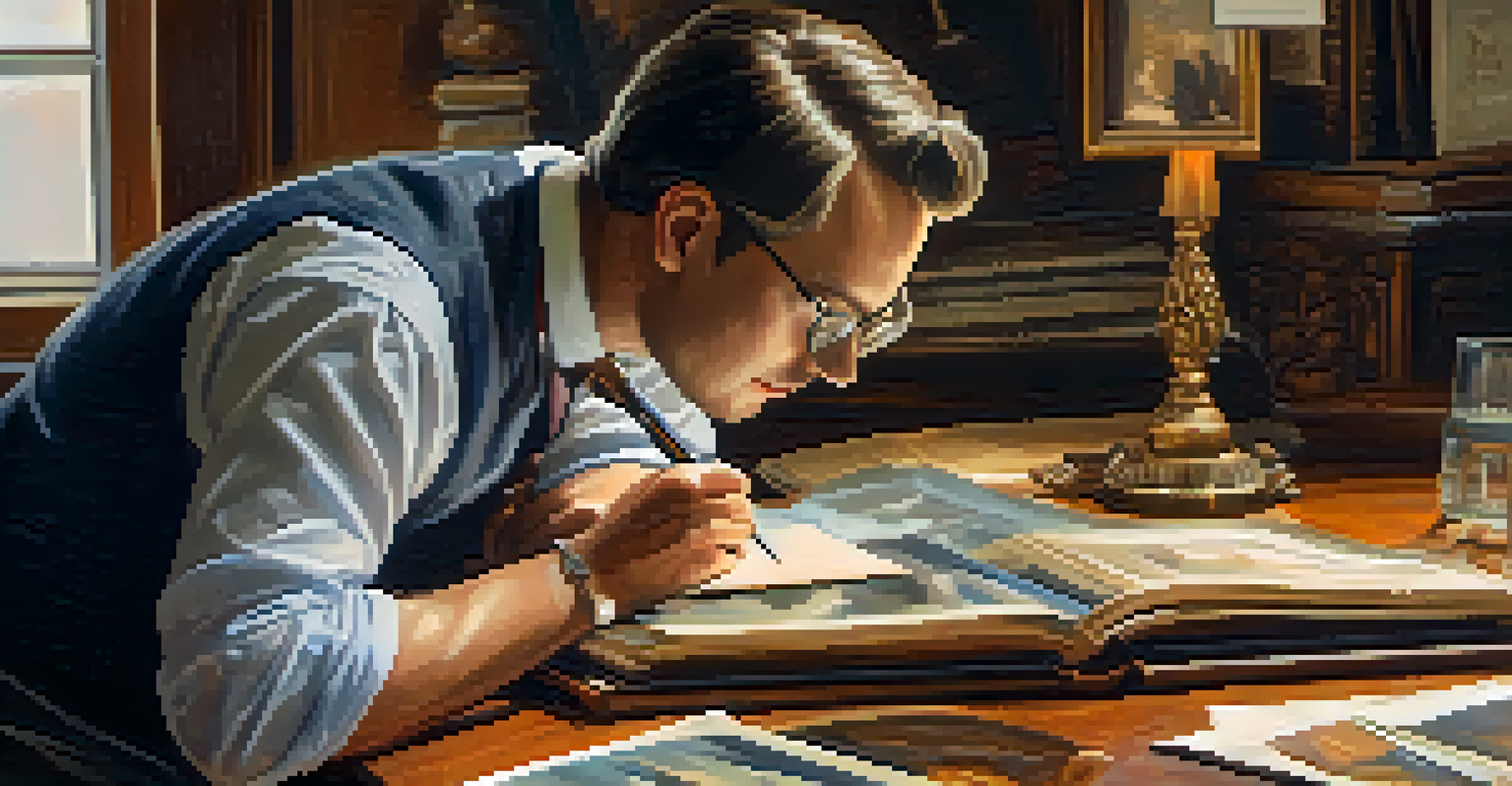Understanding Art Valuation in the Global Market Context

What is Art Valuation and Why is it Important?
Art valuation is the process of determining the monetary value of a piece of art, which can be influenced by various factors such as artist reputation, market demand, and historical significance. Understanding this valuation is crucial for collectors, investors, and museums alike, as it informs buying decisions and investment strategies.
Art is the most beautiful of all lies; it is a lie that helps us understand the truth.
A well-valued piece can appreciate over time, serving not only as a cultural asset but also as a financial investment. For instance, a painting by a renowned artist can significantly increase in value as their reputation grows, making it a desirable piece for collectors.
Moreover, accurate valuation is essential for insurance purposes and estate planning. Without a proper valuation, owners may find themselves underinsured or unable to make informed decisions regarding their art collections.
Factors Influencing Art Valuation
Art valuation is not a straightforward process; it encompasses various factors. The artist's identity plays a significant role; established artists tend to have higher valuations due to their track record and influence in the art world. Additionally, the uniqueness and rarity of a piece can greatly enhance its value.

Market trends also shape art valuation. For example, certain art movements or styles may gain popularity, leading to increased demand and higher prices. A surge in interest in contemporary art has seen many artists’ works appreciate dramatically in recent years.
Art Valuation Affects Investment
Understanding art valuation is crucial for collectors and investors as it informs buying decisions and investment strategies.
Lastly, the provenance, or history of ownership, can significantly impact value. A piece with a rich history or previous ownership by a notable collector can fetch a higher price. This factor emphasizes the importance of documentation and authenticity in the art market.
The Role of Auction Houses in Valuation
Auction houses are key players in the art valuation process, acting as intermediaries between sellers and buyers. They provide a platform where artworks are showcased and sold, often at prices that reflect current market demand. Renowned auction houses like Sotheby’s and Christie’s have a significant influence on how artworks are valued.
The value of an artwork is determined by the price someone is willing to pay for it.
These houses conduct extensive research and analysis before auctioning pieces, often consulting experts to determine potential value. Their auction results also serve as a benchmark for the market, giving insights into what collectors are willing to pay.
Moreover, auction houses have their own valuations, which can differ from appraisals by independent experts. This can lead to discrepancies, so it’s essential for buyers and sellers to understand these dynamics when navigating the art market.
Art Appraisers: Experts in Valuation
Art appraisers are professionals who specialize in determining the value of art pieces. They utilize their experience and knowledge to assess various factors, including condition, authenticity, and market trends. An appraiser's expertise can provide a well-rounded perspective on an artwork’s value.
For example, an appraiser may recognize subtle details that indicate provenance or historical significance, which a layperson might overlook. This expertise is especially valuable for collectors looking to insure their pieces or for those considering selling.
Market Trends Influence Values
Factors like artist reputation, market demand, and provenance significantly shape the valuation of artwork.
It's important to choose a certified appraiser, as their credentials assure buyers and sellers of their expertise. A well-documented appraisal can also enhance the credibility of an artwork in the marketplace.
Global Trends Affecting Art Valuation
The art market is increasingly influenced by global trends, including economic shifts and cultural movements. In times of economic uncertainty, art is often seen as a 'safe haven' investment, which can drive prices higher. Collectors may flock to established artists during these times, impacting overall valuation.
Moreover, the rise of online platforms has democratized access to the art market, allowing more people to buy and sell art. This accessibility can create a broader market, potentially increasing competition and driving prices up for popular pieces.
Cultural shifts, such as the growing appreciation for diverse artists, also reshape valuation. As new voices enter the market, their works may experience rapid appreciation, reflecting changing tastes and societal values.
The Impact of Authenticity on Valuation
Authenticity is a cornerstone of art valuation. A piece that is confirmed to be genuine carries a much higher value than one that is potentially a forgery. Collectors and investors must prioritize provenance and documentation to ensure their investments are sound.
For example, the recent rise in art forgery has led to increased scrutiny and the need for detailed records. Art experts often rely on scientific analysis and historical documentation to verify authenticity, which can significantly impact valuation.
Authenticity is Key in Valuation
Provenance and documentation are essential to verify authenticity, greatly impacting the value of art pieces.
As the art market evolves, the demand for transparency and proof of authenticity continues to grow. This trend highlights the importance of trust in the valuation process, reinforcing the need for reliable sources and expert evaluations.
Conclusion: Navigating the Art Valuation Landscape
Understanding art valuation in a global context is vital for anyone involved in the art market. From collectors to investors, being informed about the factors that influence value can help in making sound decisions. The interplay between market trends, authenticity, and expert evaluations creates a complex yet fascinating landscape.
As the art world continues to evolve, staying abreast of changes in valuation practices will be crucial. Engaging with professionals and understanding the market dynamics can empower individuals to navigate this realm more effectively.

In a world where art is both a cultural treasure and a financial asset, knowledge truly is power. Embracing the nuances of art valuation can unlock opportunities and enrich the experience of collecting and investing in art.